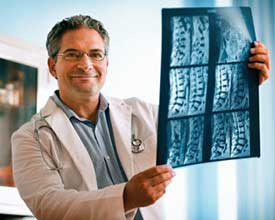X-Ray Center in Pearland, TX
What Is An X-Ray?

An X-ray is a quick, painless way to take a picture of structures inside the human body. X-rays use waves of radiation to build the image. Structures inside the body absorb the rays differently and will send back an image based on their density. Bones, which are the densest part of the body, show up white on X-ray and air is black. X-rays are most useful for gathering images of bones, but they can be used to examine many parts of the body.
Do you have questions about X-rays or would like to schedule an appointment? Please call (281) 481-2649 or contact Dr. David Vanderweide online today.
What Can An X-ray Look For?
X-rays can be used to identify or monitor:
- Broken bones
- Arthritis
- Cavities
- Osteoporosis
- Lung infections
- Breast cancer
- Heart problems
- Blocked arteries or veins
- Swallowed items and more
Today, healthcare professionals use special dye (also called contrast dye) and other types of X-rays to visualize more than just bones. Advanced techniques allow providers to examine many type of tissues including the breasts as they look for lumps that could be cancer, lung disease, blood clots and much more. Doctors who specialize in the administration and interpretation of X-rays are called radiologists.
How To Prepare For An X-Ray?
How you prepare for an X-ray will depend on the type you are having. You should expect to wear a hospital gown (in most cases) and remove any jewelry, eyeglasses, or other metal objects. You may also need to drink contrast dye or have it introduced into your body with an IV or enema depending on what part of the body is being examined.
What To Expect During The X-Ray?
X-rays are painless for most people. To begin, an X-ray technician or helper will position you on a table or other device so that the X-ray machine can be lined up with the body right body part. This may be a picture of your teeth at the dentist, or a broken leg at the hospital, so how you are positioned will vary.
Children who need an X-ray may need to be restrained so they will be still. Many children find X-rays scary and cry. This is normal. Adults who stay with them during an X-ray may need to wear a lead vest to protect their body from radiation.
Request Additional Information
To learn more or request an appointment, please call (281) 481-2649 or contact Dr. David Vanderweide online.
David G. Vanderweide MD, PA
Address
333 N Texas AveSuite 2000
Webster, TX 77598
(281) 481-2649
www.dvanderweide.com


